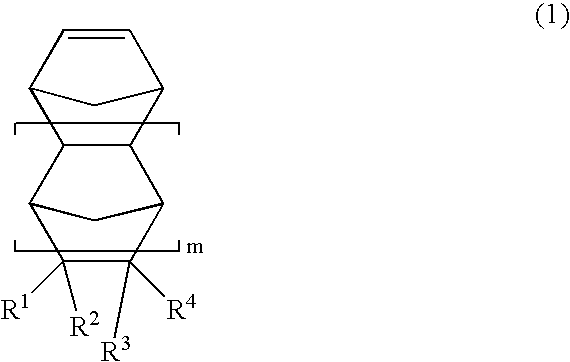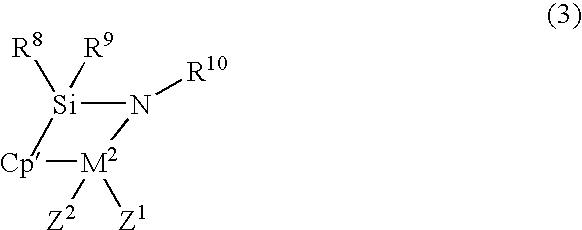Norbornene Addition Copolymer and Moldings
- Summary
- Abstract
- Description
- Claims
- Application Information
AI Technical Summary
Benefits of technology
Problems solved by technology
Method used
Image
Examples
example 1
Production of Copolymer (A)
[0105]A pressure-resistant glass reactor equipped with a stirrer was charged with 865 parts of toluene, 200 parts of tetracyclo[9.2.1.02,10.03,8]tetradeca-3,5,7,12-tetraene, 273 parts of styrene, and 0.630 parts of triethylaluminum dissolved in 5.18 parts of toluene.
[0106]43.3 parts of toluene, 0.04 parts of rac-ethylenebis(1-indenyl)zirconium dichloride, and 0.499 parts of methylaluminoxane dissolved in 2.56 parts of toluene were mixed in another glass reactor. The mixture was then added to the above reactor. After introducing ethylene gas at 0.2 MPa, polymerization was initiated at 40°C. After 120 minutes of polymerization, the polymerization solution was poured into a large quantity of hydrochloric acid / methanol to completely precipitate the polymer. After separation by filtration and washing, the polymer was dried at 60° C. for 15 hours under reduced pressure to obtain 65.2 parts of a copolymer (A).
[0107]The Mw and the Mn of the resulting copolymer (A)...
example 2
Production of Copolymer (B)
[0109]A polymerization reaction was carried out in the same manner as in Example 1 except for introducing ethylene gas at 0.05 MPa instead of ethylene gas at 0.2 MPa to obtain 61.0 parts of a copolymer (B).
[0110]The Mw and the Mn of the resulting copolymer (B) were respectively 63,900, and 30,600. The composition ratio of tetracyclo[9.2.1.02,10.03,8]tetradeca-3,5,7,12-tetraene / styrene / ethylene in the polymer was 24.8 / 17.9 / 58.1 (mol / mol / mol). The Tg of the copolymer (B) was 101°C.
[0111]The copolymer (B) was press-molded at 200° C. to obtain an optical disk substrate (B). The optical disk substrate (B) had a total light transmittance of 96%, a saturated water absorption of 0.01% or less, a birefringence value of 6 nm, a refractive index of 1.58, and a CR of 550×10−12 Pa.
example 3
Production of Copolymer (C)
[0112]A pressure-resistant glass reactor (1) equipped with a stirrer was charged with 173 parts of toluene, 75 parts of norbornene, 182 parts of styrene, and 3.86 parts of triisobutylaluminum. 0.06 parts of (t-butylamide)dimethyl-1-indenylsilanetitaniumdimethyl dissolved in 8.65 parts of toluene and 0.18 parts of trityltetrakispentafluorophenylborate dissolved in 8.65 parts of toluene were mixed in another glass reactor (2). The mixture was then added to the reactor (1). After introducing ethylene gas at 0.1 MPa into the reaction mixture in the reactor (1), polymerization was initiated at 60° C. After 60 minutes of polymerization, the polymerization solution was poured into a large quantity of hydrochloric acid / methanol. After separating the precipitate by filtration, the product was dried at 80° C. for 15 hours under reduced pressure to obtain 46.2 parts of a copolymer (C).
[0113]The Mw and the Mn of the resulting copolymer (C) were respectively 248,900, a...
PUM
| Property | Measurement | Unit |
|---|---|---|
| Substance count | aaaaa | aaaaa |
| Transparency | aaaaa | aaaaa |
| Birefringence | aaaaa | aaaaa |
Abstract
Description
Claims
Application Information
 Login to View More
Login to View More - R&D
- Intellectual Property
- Life Sciences
- Materials
- Tech Scout
- Unparalleled Data Quality
- Higher Quality Content
- 60% Fewer Hallucinations
Browse by: Latest US Patents, China's latest patents, Technical Efficacy Thesaurus, Application Domain, Technology Topic, Popular Technical Reports.
© 2025 PatSnap. All rights reserved.Legal|Privacy policy|Modern Slavery Act Transparency Statement|Sitemap|About US| Contact US: help@patsnap.com



